OzAsia festival illuminates the world of Indonesian performance and its social concerns
Barbara Hatley
In late September 2015 the city of Adelaide hosted performances by seven diverse and vibrant Indonesian theatre, dance and music groups, as well as exhibitions by five Indonesian visual/performance artists and a display of traditional masks. The occasion was the OzAsia festival, held annually since 2006, featuring arts and performance from the Asian region.
OzAsia 2016, underway right at this moment, is celebrating the 10th anniversary of the event with a diverse array of performances from many Asian countries. Previous festivals have featured one country as the major focus. In 2015 the spotlight was on Indonesia. Along with the arts events, forums on topics such as arts and Australia–Indonesia diplomacy, and Islam and diversity in contemporary Indonesia provided a broader socio-political context. A nightly food market with outdoor performances by local groups helped provide a busy, festive atmosphere.
Brother and sister with puppeteer ‘carers’ in Mwathirika - Credit: Papermoon Puppet Theatre
The Indonesian performances and artworks amply illustrated festival director Joseph Mitchell’s aim of bringing to Adelaide the work of ‘young, bold, risk-taking artists’ who create performances giving expression to the fast-paced culture around them. The works provided Australian audiences with a revealing picture of the world of contemporary Indonesian art and performance and its engagement with its socio-cultural context. This issue of Inside Indonesia begins with a review of the dance, music and theatre presented at OzAsia, while the following contributions discuss further examples of contemporary Indonesian performance, showing how they work artistically and respond to and illuminate social reality.
Artistic beauty and community development
A group of young men, torsos bared, move rhythmically across the stage, at first in near darkness accompanied by an eerie, ethereal soundscape, then bathed in red light, accompanied by pulsating clapping. As the men’s movements speed up, one breaks away, punching the air, arms spread wide, then he rejoins the group, to sway and stamp in unison once more. Eko Supriyanto’s Cry Jailolo is a result of the Javanese dancer/choreographer’s work with local youths in Jailolo, a town on Halmahera island in the remote east of Indonesia. The piece draws on the movements of a tribal dance of the region to create the image of a school of fish, moving underwater through the ocean. It celebrates the beauty of local coral reefs, now under threat from environmental degradation, and symbolises the spirit of togetherness and mutual support. The work was initially intended to promote tourism but, for Eko, it took on the role of opening up opportunities for the young dancers and their disadvantaged communities. Fusing mesmerising artistic beauty with social aims, Cry Jailolo might be seen as a particularly stunning example of performance as a medium for community development, as practiced more generally in Indonesia today.
Celebrating the local
In contrast to Cry Jailolo’s youthful, recently trained young dancers, and the newly-created work they staged, the performers of Topeng Cirebon were seasoned performers, presenting an ancient, ritually connected artistic form. The masks worn in this dance from the Cirebon area of Sunda, West Java, are imbued with great spiritual power and, in Cirebon, the dance is performed to bring blessings to those present. The performance is also spectacularly entertaining with its vigorous movements, that bring the masks alive, and the vibrant, fast-paced gamelan accompaniment.
Sleeping, existing on The Streets - Credit: Claude Raschella/OzAsia
Fast, vigorous movement and music also characterised a performance of a very different kind from West Java, SambaSunda. Here, as suggested by the name, Sundanese music, elements from other regions of Indonesia and international styles are mixed together. Loud, fast-paced, excitingly competitive drumming shifts into a haunting song by a glamorous female performer who then moves into a provocative, hip-shaking, possibly Samba-influenced dance as musicians shout and leap about and audience members clap, even dance along.
Two contrasting dance productions, one steeped in tradition, the other taking the local to a wider world, but both displaying elements of a shared Sundanese cultural style, and illustrating the blossoming of attention to local cultures which has accompanied post-Suharto centralisation in Indonesia. West Java, located between the capital city Jakarta, centre of Indonesian national culture, and Central Java, the domain of the politically and culturally dominant Javanese, is a particularly active site of such revival of local cultures. Neneng Lahpan’s contribution to this volume presents a revealing case study of these processes at work.
Tradition and innovation
The performance Sacred Sita brought together visiting Indonesian performers and local cultural enthusiasts. Javanese gamelan expert Anon Suneko Basono and his wife, dancer Asteria Retno Swastiastuti (Ias), collaborated with members of Adelaide’s Sekar Laras gamelan orchestra on a new rendition of an episode from the Ramayana epic. Shadow puppets interacted with a human dancer, accompanied by gamelan music played in a novel way – a fusion of classical tradition and contemporary innovation illustrative of a central preoccupation in the Javanese arts today. Anton Lucas and Guy Tunstill’s article describes this performance, in which the authors participated as members of the Sekar Laras orchestra, then discusses Anon’s artistic position and activities in Yogya, his deep traditional roots through family heritage and training and his enthusiastic embracing of the new.
Theatre and contemporary social reality
Two productions of contrasting dramatic styles and scales – the intimate domestic interactions among puppet characters in Papermoon Puppet Theatre’s Mwathirika and a theatre space transformed into an Indonesian street full of movement and noise in Teater Garasi’s The Streets – embodied a shared concern with exploring and bringing to attention aspects of contemporary Indonesian social reality.
Dangdut dancers strut their stuff, The Streets - Credit: Claude Raschella/OzAsia
Through their distinctive style of wordless puppet theatre, the Papermoon performers aim to communicate in a simple, direct, emotionally engaging way with audiences. In the past they have taken giant puppet figures to interact with people in public places such as markets and railway stations. In Mwathirika (meaning ‘victim’ in Swahili) they bring to life the horrific impact on families and communities of the killings and imprisonments of suspected communist sympathisers which occurred in Indonesia in 1965 as the Suharto regime took power.
The performance begins with film images, projected on to the back of the stage, of a carnivalesque political rally with loud, cheery music and much waving of red balloons. Then attention shifts to two simple village houses, in the foreground, and two puppet children playing in front of one. The little girl protests because her hobbyhorse has a damaged wheel; her older brother tries unsuccessfully to assist. Then their father returns home with a red balloon, which someone has given him from the rally. He presents it to the children who play with it happily and then go inside. A father and daughter emerge from the other house, the girl in a wheel chair. The father gives her a music box which plays a haunting silvery melody. As they re-enter the house her father waves a greeting in the direction of the neighbours. The whole scene of domestic and neighbourly interaction has a warm intimacy enhanced by the tender, affectionate way in which the puppeteers, clearly visible to the audience, look at and manipulate and their charges.
The mood suddenly changes. Loud music sounds and lights flash as a troupe of carnival players appear, somersaulting and calling out. They leave a little red whistle with the wondering children of the first house. Menacing monster figures with long beak-like noses appear, snooping around with torches, they spot the red balloon placed before the first house and the father sitting outside mending his daughter’s damaged hobbyhorse. ‘Is this the owner of the house with the balloon?’ they signal to the neighbour standing nearby. He nods and the monsters seize the father roughly and drag him away. He has only a moment’s reprieve to pass the repaired hobbyhorse to his children before sadly farewelling them. As the days, weeks and months pass the children struggle to survive, the little girl beating her empty plate, the boy catching frogs to eat; as they fall into an exhausted sleep cradled by their puppeteers a spotlight illuminates their pitiful plight.
Below huge filmic images of turning cog wheels, beaked monsters move small figurines, painted white with a splash of red, across then off the edge of a table ― thousands of suspected communist-sympathisers thrown into oblivion. The boy tries to contact his father but is, himself, imprisoned; his sister is left alone, totally disconsolate. She refuses the gift of the music box from the girl next door, who later finds no trace of her, just a soft toy and the red whistle lying on the stage. Puzzled, the neighbour girl picks up and blows the whistle, then the stage darkens, she too disappears, and the show ends with her father holding and staring at the abandoned whistle. Balloon and whistle, mundane, everyday objects stained with the colour of communism, embody and symbolise the concocted fear and prejudice which tore apart families and communities in Indonesia in 1965. With its direct, simple style the performance is easily understood and responded to by audiences everywhere – its lessons can be applied to many situations of social conflict.
Traditional elders and young radical Muslim in conflict, The Streets - Credit: Claude Raschella/OzAsia
As Papermoon Puppet Theatre evokes the 1965 tragedy, other contemporary Indonesian theatre groups likewise dramatise particular local issues and events – migrant workers’ experiences, land disputes, gender conflicts. One troupe, meanwhile, ‘takes on the whole’. Yogyakarta-based Teater Garasi has attempted, through successive productions, to represent Indonesia as a nation in all its complexity. From 2002 to 2005 three productions of Waktu Batu (Stone Time) explored the ongoing legacies of Javanese myth and history. In Je.ja.l.an (The Streets), the performance staged at the OzAsia festival, attention focuses on the here and now, Indonesia today, imagined as a busy, crowded urban street. Entering a big open space set up as a street, with people milling about, workmen erecting lights, sellers offering their wares, a busker and mosque official soliciting donations, audience members take up positions on either side of a wide central strip. A marching band passes by and then a narrator explains that the show draws on research into street life carried out by the group. Observing the constant hectic rush of things, he frames the crucial question Kita mau kemana? (Where are we going?)
While offering no answer to the question of Indonesia’s ‘destination’, the performance provides a rich, vibrant, multi-dimensional picture of its journey. Hawkers, dancers, street walkers, Islamic radicals and moderate Muslim figures, protesters and street kids jostle for space and are confronted by whistle-blowing police. Corrugated iron sheets are used as building materials, then protective shields, and form ultra-tall ‘headdresses’ in a running dance. A narrator standing high above the throng tells the story of a soya bean cake seller who suicided after a rise in the global price of soya beans, and the recorded voice of a street kid condemns the government for its neglect of the poor. Meanwhile young women in short, sleeveless dresses perform dangdut dance; a band, Risky Summerbee and the Honeythief, which also staged its own show at the festival, plays live music, mostly pop and rock; and a wedding takes place, even though the bride, a migrant worker, is away in Malaysia. Embodied here is what Teater Garasi director, Yudi Tajuddin, refers to as the ‘chaos and creativity’ of everyday life in Indonesia, as a diverse variety of groups and identities, flourishing in the relative freedom of the post-Suharto era, compete for space and attention. There is much vibrant energy but also friction and conflict, and the sense of a headlong, uncoordinated rush into the future.
Understanding contemporary Indonesia through performance
Taken together, the Indonesian performances at OzAsia provided a picture of dynamic creativity and diverse forms of engagement with themes of rapid change, social fragmentation, global influence and legacies of past violence, along with promotion of local cultures and reinvention of tradition, as key aspects of contemporary Indonesian social experience. The theatre performances in particular conveyed a clear sense of commitment to telling this story. Visual arts exhibitions extended the picture, and discussion forums, particularly a panel on Islam and diversity in Indonesia, provided OzAsia participants with further background on the social context of Indonesian arts. Overall the festival succeeded admirably in opening up the world of Indonesian arts, performance and society to Australian audiences.
Corrugated iron ‘headdresses’, The Streets - Credit: Claude Raschella/OzAsia
The 2015 OzAsia festival is by no means unique in showcasing Indonesian arts and performance in Australia. Theatre festivals and arts events in various cities over the years have presented work by visiting Indonesian artists and locally based groups, and more extensive activities are planned. In 2017, for example, the Melbourne Arts Centre will launch a major new initiative, the Asia Pacific Triennial of Performing Arts, with Indonesian performances featuring prominently. The OzAsia program stands out, however, in the number and variety of performances reflecting on different aspects of Indonesian social reality.
Could there be a problem in presenting Indonesian arts this way to Australian audiences? Do performances that address social issues and/or celebrate local traditions tend to picture Indonesia as a culturally ‘different’ country still struggling with societal problems rather than a site of cool globally wired contemporary art? This question, raised by a member of the Teater Garasi theatre group, resonates with comments heard from Indonesian language students lamenting that Indonesia is not viewed as ‘cool’ by their peers. In actuality,of the OzAsia performances, the concert by Risky Summerbee and the Honeythief, with its bluesy sound and soulful songs in English, certainly engaged with the world of global cool. The same is true of much Indonesian popular music. But this was not the aspect of Indonesian performance highlighted at OzAsia. Instead, a Japanese show, Miss Revolutionary Idol Beserker, was celebrated as hyper-cool – ‘a frenetic spectacle of hyper-real pop music and dance … Something so out there you’re not quite sure you’re still on planet earth.’
Considered broadly, this issue might evoke questions of post-colonial identity, understandings of ‘the Other’, and the international ‘saleability’ of Indonesian art. And, on another plane, it indicates limits to the attractiveness to Australian youth of the language and culture of their nearest Asian neighbour. On a pragmatic level, it perhaps suggests the need for greater inclusiveness in Australian arts festival programs – Indonesian rock bands and hip-hop groups performing in major venues and popular public spaces. In this issue of Inside Indonesia, contributions on hip-hop and rap appear alongside discussions of more traditional dance and music and their societal connections. But Edi Dwi Riyanto’s article on the Jogja Hip Hop Foundation and Ali Crosby’s on Nova Ruth depict artists also fully engaged with and concerned about their social environment. In fusing the global and the local they add another dimension to the diverse ways in which Indonesian performance reflects on and opens up understanding of contemporary Indonesia.
Barbara Hatley (barbara.hatley@utas.edu.au) is Professor Emeritus in Asian Studies at the University of Tasmania.





